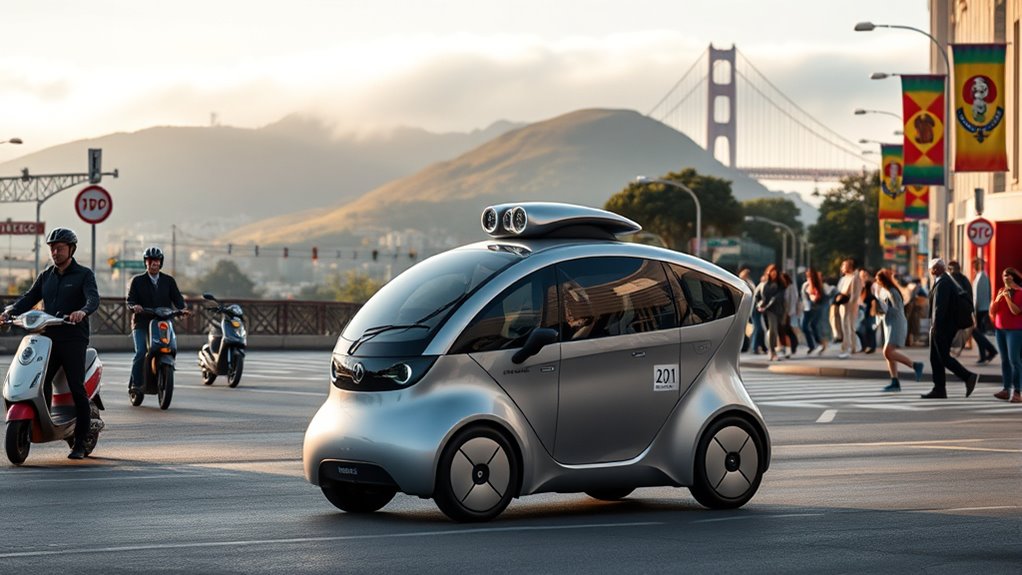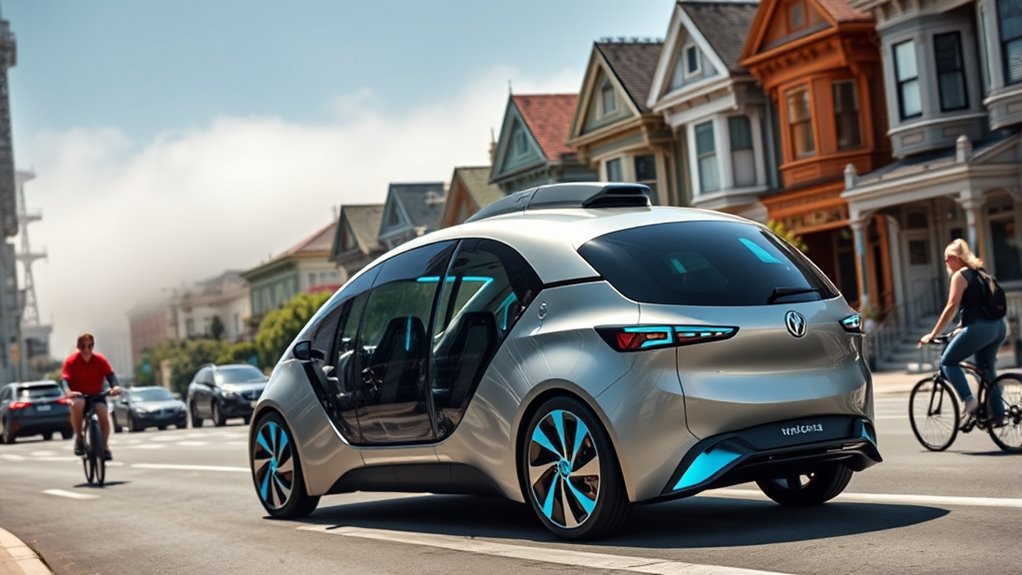San Francisco has approved the deployment of driverless robotaxis, marking a major shift in urban transit. These autonomous vehicles aim to reduce congestion, emissions, and improve access to transportation. You’ll see them navigate city streets, influencing traffic and parking patterns. Regulations ensure safety, monitor autonomous systems, and address liability concerns. As these robotaxis become more common, you’ll discover how they fit into wider city planning and future mobility developments. Keep exploring to see what’s next for urban transportation.
Key Takeaways
- San Francisco has officially approved the deployment of driverless robotaxi services on city streets.
- Regulations include strict safety standards, real-time monitoring, and human oversight during initial deployment.
- Robotaxis aim to reduce congestion, emissions, and improve transit accessibility in the city.
- Infrastructure updates like charging stations and dedicated lanes support autonomous vehicle operation.
- The deployment balances technological innovation with safety, public trust, and urban planning considerations.

San Francisco is quickly becoming a testing ground for autonomous ride-hailing services, as robotaxis roll out across the city streets. This rapid deployment raises important questions about autonomous vehicle regulations and their role in shaping urban mobility impacts. As you observe these driverless taxis maneuvering through busy intersections and tight alleyways, you might wonder how city officials are managing safety, licensing, and operational standards. The local government has implemented specific autonomous vehicle regulations to guarantee that these robotaxis operate safely and responsibly, balancing innovation with public safety concerns. These regulations typically include strict testing protocols, real-time monitoring, and requirements for human oversight during the initial phases. They aim to prevent accidents, protect pedestrians, and foster public trust in autonomous technology. Additionally, the use of vetted vehicle standards helps ensure that these autonomous systems meet safety and performance benchmarks before widespread deployment. The development of autonomous vehicle regulations is crucial for establishing a reliable framework that encourages responsible innovation. Moreover, ongoing research and regulatory updates are essential to adapt to the evolving capabilities of autonomous systems and emerging urban challenges. Implementing comprehensive safety standards is also vital for maintaining public confidence as these vehicles become more prevalent on city streets.
Your experience with robotaxis in San Francisco highlights a broader shift in urban mobility. These vehicles promise to reduce congestion, cut emissions, and provide more accessible transit options, especially for those with mobility challenges. However, their integration also disrupts traditional transportation systems. You may notice changes in traffic patterns, with some areas experiencing increased vehicle flow or altered parking dynamics as robotaxis frequently circle in search of rides or waiting for passengers. The impacts on urban mobility are complex—while these automated services can decrease personal car ownership and parking demand, they might also contribute to new congestion if not carefully managed.
Robotaxis in San Francisco reshape traffic, reduce emissions, and challenge traditional transit systems amidst evolving urban mobility.
As you ride in a robotaxi, you realize that the regulatory framework directly influences how smoothly these services operate and how they reshape city life. Cities like San Francisco are actively refining policies to address issues like data privacy, cyber-security, and liability in case of accidents. These regulations are vital for maintaining a balance between technological advancement and public interest. They also influence the pace and scope of deployment, determining whether robotaxis become a seamless part of daily life or remain a niche service.
Furthermore, the presence of autonomous vehicles impacts urban planning and infrastructure. You might see new charging stations, dedicated lanes, or updated signage to accommodate the tech. The regulatory environment encourages companies to innovate responsibly, fostering competition while safeguarding residents. Ultimately, as these driverless taxis become more prevalent, they will shape how you move around the city, influence traffic flow, and redefine what urban mobility means in the age of automation. Balancing innovation with regulations is key to guaranteeing that these autonomous vehicle systems benefit everyone without compromising safety or city livability.
Frequently Asked Questions
How Will Robotaxi Services Impact Local Employment Rates?
You might see changes in the labor market as robotaxi services roll out, leading to employment shifts in traditional taxi and ride-share jobs. While automation can reduce demand for drivers, it could also create new roles in tech support and vehicle maintenance. Overall, your local employment landscape could adjust, with some jobs disappearing and others emerging, impacting the availability and types of work within your community.
What Safety Measures Are in Place for Passenger Security?
Imagine a safety net woven with care—your security is the priority. Drivers undergo rigorous training and are prepared with emergency protocols, ensuring they respond swiftly and effectively. Advanced sensors and real-time monitoring systems act as vigilant guardians, constantly scanning for hazards. These measures work together to protect you, turning autonomous rides into safe journeys. Trust that every detail is designed to keep you secure, no matter what road you take.
How Will Data Privacy Be Protected With Driverless Taxis?
You might wonder how your data privacy is protected with driverless taxis. These services use data encryption to secure your information from unauthorized access, ensuring your personal details stay safe. Additionally, they must comply with strict privacy regulations that govern data collection and sharing. By following these measures, the companies aim to safeguard your privacy, giving you confidence in using autonomous taxis without concerns about data breaches or misuse.
Are There Plans to Expand Robotaxi Services Beyond San Francisco?
Imagine city streets buzzing with driverless taxis beyond San Francisco, weaving through neighborhoods and suburbs. While expansion excites many, it hinges on overcoming regional regulations and technological challenges. You’ll see policymakers and tech companies working together, addressing safety and infrastructure issues. As these hurdles clear, expect robotaxi services to spread, offering more riders convenient, autonomous transportation options in diverse areas, transforming your commute across broader regions.
What Are the Cost Differences Between Robotaxis and Traditional Taxis?
When comparing fares, robotaxis often cost less than traditional taxis because of lower operational costs, like no driver wages and reduced insurance expenses. You’ll notice the fare difference is typically noticeable, especially during peak hours. As a passenger, you benefit from these savings, making robotaxis a more affordable option for many trips. Over time, these lower operational costs could lead to even more competitive prices for riders.
Conclusion
As you watch robotaxis hit the streets, it’s tempting to see them as the future of transportation. While some believe they’ll revolutionize travel and reduce accidents, others argue they might lead to job losses and new safety risks. Although technology advances, it’s worth questioning whether AI can fully replace human judgment in unpredictable situations. So, as San Francisco embraces driverless taxis, you should stay curious about whether these robots truly offer a safer, more efficient future—or just a new set of challenges.









